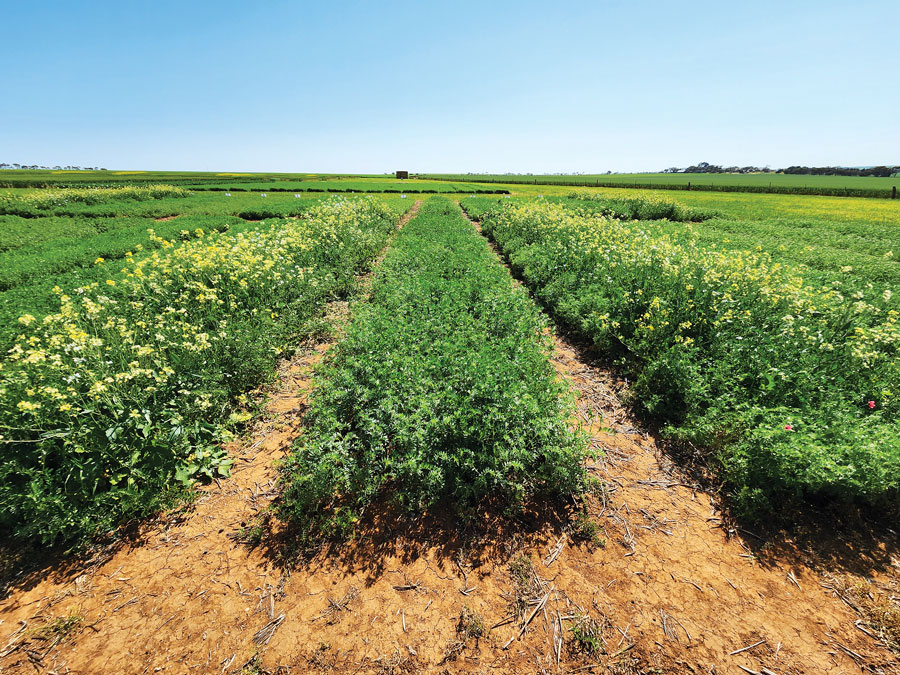Research in South Australia has been developing best practice agronomy to help growers close the yield gap in pulses affected by increasing herbicide resistance in broadleaf weeds
The constraint imposed by broadleaf weeds on pulse crop yields has been compounded in recent years by increasing herbicide resistance, particularly to Group 2 imidazolinone (IMI) herbicides.
A GRDC-supported project has been addressing this – aiming to close the 40 per cent yield gap between average grain legume yields and water-limited yield potential. Central to the research is the development of best-practice grain legume agronomy strategies.
Broadleaf weed control
Dr Navneet Aggarwal, senior research agronomist (weed ecology) at the South Australia Department of Primary Industries and Regions’ research division – the South Australian Research and Development Institute (SARDI) – is leading the research.
He is looking into improved options for broadleaf weed control, pointing out that growers have multiple options in cereals but not in pulses.
Growers in South Australia are planting lentils in challenging conditions, such as sandy or alkaline soils, where crop safety from herbicide damage and effective weed control can be a challenge.
“A suite of tactics is required to effectively control broadleaf weeds and delay the build-up of herbicide resistance in pulses,” Dr Aggarwal says.
One of the first lines of defence against increased herbicide resistance in broadleaf weeds is to use different modes of action (MOAs). Newly registered herbicides, such as Reflex® and Terrain® (Group 14, previously Group G), have made this possible, but they come with a potential for crop damage.
“Lentil is the most sensitive of the pulse crops to these herbicides and growers adopting these herbicides should carefully read label recommendations before use,” Dr Aggarwal says.
Multiple soil tests
The research – by Trengove Consulting Trust and SARDI agronomy teams based at Port Lincoln and Minnipa, with support from GRDC and the South Australian Grain Industry Trust (SAGIT) – took place across seasons and soil types to fully understand the risk profile and assist with determining safe herbicide combinations and rates of these new chemicals.
“Reflex® and Terrain® were associated with stunting in lentils, and Terrain® also reduced plant establishment compared to the unsprayed control,” Dr Aggarwal says. “On alkaline sandy and alkaline medium-textured soils, Reflex®, Terrain®, diuron, metribuzin and terbuthylazine herbicides incurred more damage than on acidic sandy and neutral medium-textured soils than other treatments.
“Crop damage from Reflex® and Terrain® on alkaline sands was cumulative when applied in combination with diuron and metribuzin.” (These combinations are not supported by the product labels and were done for research purposes only.)
Dr Aggarwal says seasonal variation, including higher rainfall post-seeding, may have been a contributing factor to higher levels of crop damage in alkaline sandy soils: “The crop recovery from this herbicide damage was highly dependent on seasonal weather conditions, with better recovery in 2022 due to higher spring rainfall compared with 2021.
“Crop damage with Reflex® on alkaline sands was rate responsive, with yield loss in a trial at Bute increasing from 17 per cent when applied at 0.5 litres per hectare to 54 per cent when applied at 1L/ha.”
An additional research finding was that control of bifora, common sow thistle, Indian hedge mustard and marshmallow weed populations was achieved with Reflex® and Terrain® applied in combination with registered Group 2, 5 and 12 herbicides.
In summary, the research findings continue to support the need for growers to carefully plan weed control on acidic, alkaline and sandy soils to achieve the optimal balance of weed control and crop safety.

The SA Grain Legume Project is developing improved strategies for broadleaf weed control in pulses. Photo: supplied
Herbicide-tolerant pulse varieties
Pulse varieties that are tolerant to different herbicides are also being tested.
Dr Aggarwal and his collaborating team have been researching a metribuzin-tolerant SARDI lentil germplasm line and the new commercial metribuzin-tolerant variety GIA Metro, including demonstration trials at Tooligie and Kimba on the Eyre Peninsula.
The research has found the use of metribuzin at the highest label rates – applied either as post-sowing pre-emergent or post-emergent at the 5th to 6th node lentil growth stage – in both the germplasm line and GIA Metro provided improved control of broadleaf weeds compared with the lowest label rates, including weeds that have developed resistance to IMI herbicides.
Good control was achieved for weeds such as bifora, Indian hedge mustard, wild turnip, common sow thistle and prickly lettuce (bifora and prickly lettuce are not listed on current metribuzin labels).
“We are advising growers about the benefits of adopting GIA Metro for improved broadleaf weed control,” Dr Aggarwal says.
“Increased adoption of this variety will reduce selection pressure and delay resistance build up to a particular MOA.
“Growers must refer to the new permit (PER92810) for metribuzin use in GIA Metro in varying soil and weather conditions, as granted by Australian Pesticides and Veterinary Medicines Authority in December 2022.”
Dr Aggarwal says GIA Metro is associated with a fitness penalty, with GRDC National Variety Trials in SA, Victoria, Western Australia and New South Wales in 2021 and 2022 finding GIA Metro yielded 20 to 30 per cent lower than PBA Hurricane XT – although this is being addressed through
plant breeding.
“However, compared to situations with unsatisfactory weed control due to IMI-resistant broadleaf weeds, the associated benefits of improved broadleaf weed control has the potential to reduce this yield sacrifice,” he says.
“In addition, improved weed control in lentil has the additional benefit of reducing the soil weed seedbank burden of resistant weeds for subsequent seasons.”
Balancing crop safety and weed control
Dr Aggarwal says the key to broadleaf weed management is striking the right balance between crop safety (herbicide damaging the crop itself), weed control and herbicide resistance management.
“A key message is to use different crop rotation strategies – don’t rely too heavily on the same mode of action,” he says.
“Crop safety is paramount – if we use herbicides at their maximum label rate in lentils, especially in challenging sandy and alkaline soils, we risk crop damage.”
Research engagement
Findings from the research will help growers make decisions for managing broadleaf weeds.
Dr Aggarwal has observed that as more growers have adopted or expanded pulse production, they have become more engaged with weeds research. This is something that the SA Grain Legume Project has fostered through events at project sites at Hart in the mid north, Tooligie and Kimba on the Eyre Peninsula, and Pinnaroo in the Mallee.
“We plan our experiments to demonstrate new weed management strategies, as well as to compare this to what growers are doing now,” he says.
“When we see differences between current and new practices, there’s a real understanding.
“However, we need more answers about how to best grow them in regions where they haven’t been grown in the past,” he says. “Ultimately, that’s one of the major aims of this project.”
More information: Dr Navneet Aggarwal, navneet.aggarwal@sa.gov.au
PIRSA Media, pirsa.media@sa.gov.au

























































